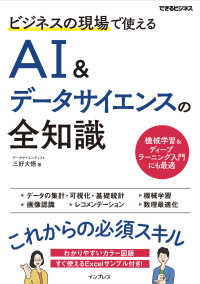基本説明
The overarching aim of the volume is first to take stock of the variety of existing multilingual corpora, documenting possible corpus designs and uses, second to discuss methodological and technological challenges in the creation and analysis of multilingual corpora, and third to provide examples of linguistic analyses that were carried out on the basis of multilingual corpora.
Full Description
This volume deals with different aspects of the creation and use of multilingual corpora. The term 'multilingual corpus' is understood in a comprehensive sense, meaning any systematic collection of empirical language data enabling linguists to carry out analyses of multilingual individuals, multilingual societies or multilingual communication. The individual contributions are thus concerned with a variety of spoken and written corpora ranging from learner and attrition corpora, language contact corpora and interpreting corpora to comparable and parallel corpora. The overarching aim of the volume is first to take stock of the variety of existing multilingual corpora, documenting possible corpus designs and uses, second to discuss methodological and technological challenges in the creation and analysis of multilingual corpora, and third to provide examples of linguistic analyses that were carried out on the basis of multilingual corpora.
Contents
1. Introduction (by Schmidt, Thomas); 2. Section 1. Learner and attrition corpora; 3. The LeaP corpus: A multilingual corpus of spoken learner German and learner English (by Gut, Ulrike); 4. Technological and methodological challenges in creating, annotating and sharing a learner corpus of spoken German (by Hedeland, Hanna); 5. Creation and analysis of a reading comprehension exercise corpus: Towards evaluating meaning in context (by Ott, Niels); 6. The ALeSKo learner corpus: Design - annotation - quantitative analyses (by Zinsmeister, Heike); 7. Corpora of spoken Spanish by simultaneous and successive German-Spanish bilingual and Spanish monolingual children (by Ulloa, Marta Saceda); 8. Monolingual and bilingual phonoprosodic corpora of child German and child Spanish (by Lleo, Conxita); 9. Pragmatic corpus analysis, exemplified by Turkish-German bilingual and monolingual data (by Herkenrath, Annette); 10. Corpus of Polish spoken in Germany: Collecting and analysing written & spoken data for investigating contact-induced change (by Czachor, Agnieszka); 11. The HABLA-corpus (German-French and German-Italian) (by Kupisch, Tanja); 12. Section 2. Language contact corpora; 13. The Hamburg Corpus of Argentinean Spanish (HaCASpa) (by Gabriel, Christoph); 14. Ad hoc contact phenomena or established features of a contact variety?: Evidence from corpus analysis (by Kuhl, Karoline); 15. Phonoprosodic corpus of spoken Catalan (PhonCAT) (by Benet, Ariadna); 16. Researching the intelligibility of a (German) dialect (by Putz, Magdalena); 17. Annotating ambiguity: Insights from a corpus-based study on syntactic change in Old Swedish (by Hoder, Steffen); 18. Section 3. Interpreting corpora; 19. Sharing community interpreting corpora: A pilot study (by Angermeyer, Philipp S.); 20. CoSi - A Corpus of Consecutive and Simultaneous Interpreting (by House, Juliane); 21. The corpus "Interpreting in Hospitals": Possible applications for research and communication training (by Buhrig, Kristin); 22. Section 4. Comparable and parallel corpora; 23. The GeWiss corpus: Comparing spoken academic German, English and Polish (by Fandrych, Christian); 24. Korpus C4: A distributed corpus of German varieties (by Dittmann, Henrik); 25. Treebanks in translation studies: The CroCo Dependency Treebank (by Culo, Oliver); 26. Section 5. Corpus tools; 27. Multilingual phonological corpus analysis: The tools behind the PhonBank Project (by Rose, Yvan); 28. Finding the balance between strict defaults and total openness: Collecting and managing metadata for spoken language corpora with the EXMARaLDA Corpus Manager (by Worner, Kai); 29. General index; 30. Corpora index; 31. Language index








